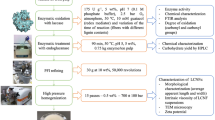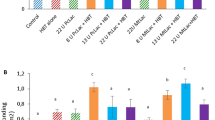Abstract
In this work, the effect of Trametes pubescens laccase (TpL) used in combination with a low-molecular-weight ultra-filtered lignin (UFL) to improve mechanical properties of kraft liner pulp and chemi-thermo-mechanical pulp was studied. UFL was isolated by ultra-filtration from the kraft cooking black liquor obtained from softwood pulping. This by-product from the pulp industry contains an oligomeric lignin with almost twice the amount of free phenolic moieties than residual kraft pulp lignin. The reactivity of TpL on UFL and kraft pulp was studied by nuclear magnetic resonance spectroscopy and size exclusion chromatography. Laccase was shown to polymerise UFL and residual kraft pulp lignin in the fibres, seen by the increase in their average molecular weight and in the case of UFL as a decrease in the amount of phenolic hydroxyls. The laccase initiated cross-linking of lignin, mediated by UFL, which gives rise to more than a twofold increase in wet strength of kraft liner pulp handsheets without loosing other critical mechanical properties. Hence, this could be an interesting path to decrease mechano-sorptive creep that has been reported to lessen in extent as wet strength is given to papers. The laccase/2,2′-azino-bis(3-ethylbenzothiazoline-6-sulphonic acid) (ABTS) mediator system showed a greater increase in wet tensile strength of the resulting pulp sheets than the laccase/UFL system. However, other mechanical properties such as dry tensile strength, compression strength and Scott Bond internal strength were negatively affected by the laccase/ABTS system.




Similar content being viewed by others
References
Balakshin M, Capanema E, Chen CL, Gratzl J, Kirkman A, Gracz H (2001) Biobleaching of pulp with dioxygen in the laccase-mediator system—reaction mechanism for degradation of residual lignin. J Mol Catal B Enzym 13:1–16
Barsberg S, Elder T, Felby C (1997) Extension of the oxidative action of laccase into the lignin matrix of the plant cell wall by radical mobility. In: Proceedings of the 9th International Symposium on Wood and Pulping Chemistry (ISWPC). Part 1 (of 2), Montreal, Can, Jun 9–12. ACM, New York, pp E 2.1–E 2.5
Bourbonnais R, Paice MG (1990) Oxidation of non-phenolic substrates. An expanded role for laccase in lignin biodegradation. FEBS Lett 267:99–102
Buchert J, Grönqvist S, Mikkonen H, Oksanen T, Peltonen S, Suurnäkki A, Viikari L (2005) Process for producing a fibrous product. European Patent WO2005061790
Call HP, Mücke I (1997) History, overview and application of mediated lignolytic systems, especially laccase-mediator-systems (LignozymR-process). J Biotechnol 53:163–202
Carnevali C, Orlandi M, Zoia L, Scotti R, Tolppa EL, Sipila J, Agnoli F, Morazzoni F (2005) Radicalization of lignocellulosic fibers, related structural and morphological changes. Biomacromolecules 6:1592–1601
Caulfield DF (1994) Ester cross-linking to improve wet performance of paper using multifunctional Carboxylic-Acids, Butanetetracarboxylic and Citric-Acid. Tappi J 77:205–212
Chandra RP, Ragauskas AJ (2002) Evaluating laccase facilitated coupling of Phenolic Acids to high-kappa kraft pulps. Enzyme Microb Technol 30:855–861
Chandra RP, Lehtonen LK, Ragauskas AJ (2004) Modification of high lignin content kraft pulps with Laccase to improve paper strength properties. 1. Laccase treatement in the presence of Gallic Acid. Biotechnol Prog 20:255–261
Crestini C, Argyropoulos DS (1998) The early oxidative biodegradation step of residual kraft lignin models with laccase. Bioorg Medic Chem 6:2161–2169
Elegir G, Daina S, Bestetti G, Orlandi M (2005) Laccase mediator system: oxidation of recalcitrant model structures present in residual kraft lignin. Enzyme Microb Technol 37:340–346
Espy HH (1995) The mechanism of wet-strength development in paper—a review. Tappi J 78:90–99
Felby C, Hassingboe J, Lund M (2002) Pilote-scale production of fibreboard made by laccase oxidized wood fibers: board properties and evidence for cross-linking of lignin. Enzyme Microb Technol 31:736–741
Fukushima Y, Kirk T (1995) Laccase component of the Ceriporiopsis subvermispora lignin-degrading system. Appl Environ Microbiol 61:872–876
Galhaup C, Haltrich D (2001) Enhanced formation of laccase activity by the white-rot fungus Trametes pubescens in the presence of copper. Appl Microbiol Biotechnol 56:225–232
Gellerstedt G (1992) Gel permeation chromatography. In: Lin SY, Dence CW (eds) Methods in lignin chemistry. Springer, Heidelberg, pp 487–497
Gellerstedt G, Pranda J, Lindfors EL (1994) Structural and molecular properties of residual birch kraft lignins. J Wood Chem Technol 14:467–482
Gierer J, Lindeberg O (1980) Reactions of lignin during sulfate pulping. Isolation and identification of new dimers from a spent sulfate liquor. Acta Chem Scand B Org Chem Biochem 34:161–170
Girardin M, Metche M (1983) Rapid micro determination of alkoxyl groups by gas chromatography. Application to lignin. J Chromatogr 264:155–158
Grönqvist S, Buchert J, Rantanen K, Viikari L, Suurnäkki A (2003) Activity of laccase on unbleached and bleached thermomechanical pulp. Enzyme Microb Technol 32:439–445
Himmel ME, Tatsumoto K, Oh KK, Grohmann K, Johnson DK, Li Chum H (1989) Molecular weight distribution of aspen lignins estimated by universal calibration. In: Glasser WG, Sarkanen S (eds) Lignin properties and materials. American Chemical Society, Washington, DC, pp 82–99
Kawai S, Umezawa T, Higuchi T (2002) Degradation mechanism of phenolic β-1 lignin substructure model compound by laccase of Coriolus versicolor. Arch Biochem Biophys 262:99–110
Kawai S, Iwatsuki M, Nakagawa M, Inagaki M, Hamabe A, Ohashi H (2004) An alternative β-ether cleavage pathway for a non phenolic β-O-4 lignin model dimer catalysed by a laccase mediator system. Enzyme Microb Technol 35:154–160
Keyoumu A, Sjödahl R, Henriksson G, Ek M, Gellerstedt G, Lindström ME (2004) Continuous nano- and ultra-filtration of kraft pulping black liquor with ceramic filters—a method for lowering the load on the recovery boiler while generating valuable side-products. Ind Crops Products 20:143–150
Leonowicz A, Cho NS, Luterek J, Wilkolazka A, Wasilewska MW, Matuszewska A, Hofrichter M, Wesenberg D, Rogalski J (2001) Fungal laccase: properties and activity on lignin. J Basic Microbiol 41:185–227
Li K, Xu F, Erikssen KEL (1999) Comparison of fungal laccases and redox mediators of a non phenolic lignin model compound. Appl Environ Microbiol 65:2654–2660
Lund M, Felby C (2001) Wet strength improvement of unbleached kraft pulp through laccase catalyzed oxidation. Enzyme Microb Technol 28:760–765
Poppius-Levlin K, Whang W, Tamminen T, Hortling B, Viikari L, Niku-Paavola ML (1999) Effects of laccase/HBT treatment on pulp and lignin structures. J Pulp Pap Sci 25:90–94
Rochefort D, Leech D, Bourbonnais R (2004) Electron transfer mediator systems for bleaching of paper pulp. Green Chem 6:14–24
Sjöberg J, Kleen M, Dahlman O, Agnemo R, Sundvall H (2002) Analyses of carbohydrates and lignin in the surface and inner layers of softwood pulp fibers obtained employing various alkaline cooking processes. Nordic Pulp Paper Res J 17:295–301
Westermark U, Lidbrandt O, Eriksson I (1988) Lignin distribution in spruce (Picea abies) determined by mercurization with SEM-EDXA technique. Wood Sci Technol 22:243–250
Wong KKY, Richardson JD, Mansfield SD (2000) Enzymatic treatment of mechanical pulp for improving papermaking properties. Biotechnol Prog 16:1025–1029
Acknowledgement
This work has been financially supported by SustainPack, a European Union 6th Framework Programme. Smurfit Kappa Kraftliner Piteå and Stora Enso Kaukopää are gratefully acknowledged for supplying the pulps, and Korsnäs is acknowledged for supplying the black liquor.
Author information
Authors and Affiliations
Corresponding author
Rights and permissions
About this article
Cite this article
Elegir, G., Bussini, D., Antonsson, S. et al. Laccase-initiated cross-linking of lignocellulose fibres using a ultra-filtered lignin isolated from kraft black liquor. Appl Microbiol Biotechnol 77, 809–817 (2007). https://doi.org/10.1007/s00253-007-1203-6
Received:
Revised:
Accepted:
Published:
Issue Date:
DOI: https://doi.org/10.1007/s00253-007-1203-6




